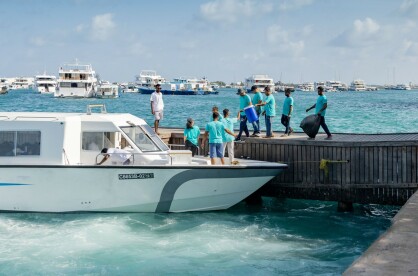Thilafushi is the trash island of the Maldives, designated as a landfill at the close of 1991. Thilafalhu was initially a lagoon with a length of seven kilometres, and a width of 200 metres at the shallowest points, and was not being utilised for anything worth mentioning at that time. What was already a questionable affair, 1,060 cubic metre pits were dug, as cells, using the excavated sand as high walls, into which garbage brought from the bustling city of Malé was being dumped and then covered with white sand. The process went on for decades, with the curious lack of critical thinking as to whether or not this would be sustainable. The garbage was not disappearing when covered with a layer of sand, as some may have hoped.
Arriving at the turn of the 2010s, and haze was a frequent visitor in the streets of Malé, simply because of the smoke that was being blown over from neighbouring Thilafushi. Where did they go wrong? They mused naively.
Before the issue of the non-disposal of trash arose, Thilafushi was also being utilised as an industrial zone. Business offices, warehouses, factories for cement, methane bottling, and other heavy industry, were green-lighted in 1997 as the terrestrial growth of the island was noticed. The constant digging, stuffing of trash, and then digging again, expanded the island’s land noticeably, and the Maumoon Regime piped down on the potential benefits. Boat manufacturing, an industry that is arguably keeping the rest of Maldivian commerce afloat, was also established; it was business as usual. It is reported that the initial land use generated over a million USD in government revenue per year, quite a substantial amount at that time.
As the industries went on, and Thilafushi was also used as a landing for imports of heavy raw materials, the garbage issue was silently and insistently overlooked. Environmental impact assessments showed how not only were the sunken refuse polluting the oceans, but some boat captains who were ferrying trash in from around the country were impatient enough to dump their toxic cargo into undesignated areas, further exacerbating the issue. The impact was huge enough that multiple international news agencies zeroed in on the ‘trash island of paradise’, and attention was finally rekindled.
To try and control the unlicensed and uncontrolled trash dumping, administrative duties of Thilafushi were transferred to the Malé City Council. They wanted to take it a step further and at least attempt at achieving a global standard of waste management, contracting with an Indian company in 2011. However, and quite unsurprisingly given the fickleness of Maldivian politics, the deal fell through and was forgotten. BBC however took it upon themselves to remind everyone that Thilafushi, at its current state, was “apocalyptic”.
When the problem became a literal mountain, Thilafushi was set on fire.
The mountains of trash were set alight in an attempt to make the trash disappear, but the ten hectares of burning refuse now contributed catastrophic effects on the environment. Smog would eventually swoop into the surrounding islands, including Malé, creating alarming health conditions, and becoming a general, albeit annoying, part of daily life. The issue was going out of hand and spreading like wildfire, and a solution did not seem to present itself.
With the Yameen Administration hammering through the tenure with industrialisation, a plan to relocate the main port of Malé to Thilafushi was also proposed, but not followed through. This would have eased the trading deadlock of containers and cargo movement in the Maafannu area of Malé, and also pushed for better management of the Thilafushi land expanse, yet not enough of a push was present. While Maldives Ports Limited (MPL) and Customs cargo management involved land in Hulhumalé to alleviate the pressures on the congested streets, further development of Thilafushi was not in the works as of yet. However, the plan to bring an incinerator, initially with the partnership of Sri Lanka as per the contract awarded in 2017, was finally taking form earlier this year.
This year, with the industrious Minister of Environment, Climate Change and Technology; Aminath Shauna, and the Special Envoy for Climate Change Sabra Ibrahim Noordeen at the helm, the Maldivian environmental agencies were mobilised once more. There are currently deals with the Asian Development Bank to finance proper waste management facilities, and also the much needed-Waste to Energy systems. A sizeable incinerator is to be utilised to both get rid of the trash, while reducing the release of toxic gases into the atmosphere, and also generate electricity. Further utilisation of the industrial and warehousing areas, also connected to much awaited relocation of chemical storage facilities from residential Malé to Thilafushi, meant that Thilafushi was gearing up to be an industrial hub for the Greater Malé Region, as it has been jurisdictionally reassigned.
The largest boatyard in the country is also operating ceaselessly from the island, and further changes are being brought to alleviate the unplanned, exponential growth of the central population and economy. However, given the disappointing track record of Maldivian administrations and their big plans, the people need to be vigilant around the changes and deals that are taking place.
The Strategic Action Plan of the current government for 2019-2023 recognised that solid waste management is the most visible and pressing environmental issue, with plans to invest heavily on waste management, climate and disaster resilient infrastructure — given the nearly 300,000 cubic metres of waste that were washed out during the 2004 tsunami — and also intense attention and scrutiny given to monitoring and administrative capacity building in this regard.
According to the summary report on the Greater Male Waste-to-Energy Project, there are plans in the works to partner up with international institutions to achieve these goals. The key development partners are the Organization of the Petroleum Exporting Countries Fund for International Development (Zone 1); the Abu Dhabi Fund for Development, the International Renewable Energy Agency, and the World Bank (Zone 2); Asian Development Bank (ADB), the Asian Infrastructure Investment Bank (AIIB), and the Islamic Development Bank (IsDB) (Zone 3); the World Bank and the Government of Denmark (Zone 4); the World Bank (Zone 5); the United Nations Environment Programme, and the Ministry of the Environment of the Government of Japan (Zone 6); and the Abu Dhabi Fund for Development and the International Renewable Energy Agency (Zone 7). The zones are those designated in the plan partitioning the land areas of Thilafushi.
If the work goes according to plan, the people may yet see a smog-free horizon towards the west. What also needs to be done, as the Solih Administration’s bridge plans are being established, is to utilise as much sustainable energy and industry as possible when building up this potential niche of the economy. Sustainability has to be the keyword in every step of Maldivian economic growth, and the lack of that concept in 1991 should be a lesson for generations to come.







